Receiving of Goods
Receiving is the collection of activities involved in
- the orderly receipt of all materials coming into the warehouse,
- providing the assurance that the quantity and quality of such materials are as ordered, and
- disbursing materials to storage or to other organisational functions requiring them.
Functions of Receiving
- The objective of the receiving function is to assure that goods and materials delivered to warehouses are verified against ordering documentation and checked for shipping damage.
- In the receiving area, incoming goods and materials are normally unpacked, checked for quantity accuracy and product damage, repackaged, organized into a storable format (where required), entered into the inventory system, have markings / labels applied, and staged for movement to a storage area.
- Cross-docking and certain value-added activities could also take place here.
Typical activities carried out in the receiving of goods include:
- Scheduling delivery vehicles and yard control
- Unloading product from the delivery vehicles
- Checking product quality and quantity
- Entering data into the warehouse management inventory system
- Safeguarding and labelling
- Completing JIT and cross-dock activity
Scheduling Delivery Vehicles and Yard Control
- Yard control activities include scheduling inbound vehicles for offloading, restraining vehicles, checking seals, opening of the truck door, and inspecting the trailer or load condition.
- Yard control and scheduling inbound delivery vehicles determines when delivery trucks are due to be positioned at the warehouses unloading dock.
- Other yard control activities include:
- Using chocks behind the trailer driver side rear wheels or other means of vehicle restraint
- Checking the seal and opening the truck door
- Inspecting the trailer or load condition for damage or contaminants
- When trucks arrive at the dock, they generally find one of three types of warehouse dock configurations: combined, scattered, or separated.
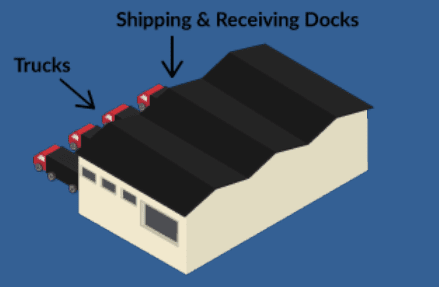

Combined Dock
- In the combination docks arrangement receiving and shipping activities are performed in one common area, so fewer dock positions are needed. These activities use the same docks, building area, equipment, and employees and lead to a more productive use of resources. For best results, this combination concept requires a truck dock schedule in which inbound and outbound products do not conflict. Receiving and shipping docks are on the same wall, so product tends to flow through the facility in a horseshoe pattern.
Scattered Dock
- A scattered dock arrangement has incoming goods delivered to a number of points on the perimeter of a warehouse close to the point of use.
- This dock arrangement allows the product to flow directly from the delivery dock area to the assigned storage use/area.
- Shipping docks are located along the opposite building wall from the receiving docks, allowing product to flow from use/storage areas into the shipping dock area.
- This arrangement is particularly suitable for warehouses that operate a cross-docking operation.
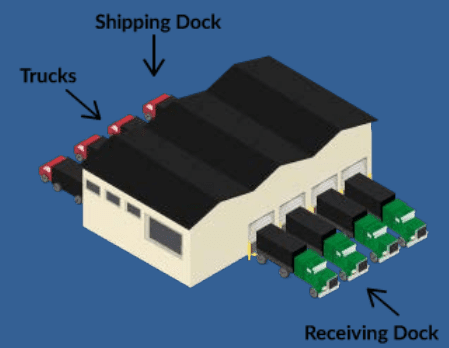

Separated Dock
- In the separated dock arrangement incoming goods are delivered to a number of points on the perimeter along one exterior wall.
- This dock arrangement allows the product to flow directly in a straight line from the receiving dock area to the assigned storage area.
- Shipping docks are located along the opposite exterior wall from receiving, allowing product to flow from storage areas into the shipping dock area.
Check Product Quality and Verify Quantity
- The third main receiving activity is to verify that incoming goods and materials are not damaged or contaminated and that the quantity is verified against what was ordered.
- This activity ensures that the product delivered to warehouses is what was ordered, the quality is acceptable, and the quantity is correct.
- Once a receipt has been verified for quality and quantity, it is entered into a WMS. At this point, any discrepancies are documented using the designated process.
- Any missing or damaged cartons in transit may become the responsibility of the freight carrier or transport company.
- Suppliers and manufacturers would be notified if the order is damaged, contaminated, has incorrect quantities, or has missing or wrong products.
Entering Data into the Warehouse Management System
- The next receiving activity is to update the inventory system.
- Receiving department employees enter the SKU quantities into the system and transfer the goods from the receiving department staging area to the designated storage or staging area.
- In warehouses that use barcode scanners or other means of capturing receipt information, employees ensure that data is automatically entered during the scanning process.
- In warehouses that use paper-based transactions (e.g., receiving documents), employees may need a more extensive key entry to input product and quantity data.
Safeguarding And Labelling
- In SKU labelling activities, a unique label is placed onto each SKU.
- A mechanical printer prints labels which are then glued, clipped to, stitched into, or hooked onto the SKU.
- Repackaging and other safeguarding operations may take place prior to further processing and storage.
- The purpose of this activity is to convert the product from a bulk form (e.g., products tossed into a large bin without individual packaging or wrapping) to a form that is ready to be placed into storage.
Value-Added Activities in Receiving
- Receiving functions also include activities, such as repacking products, repackaging into customer specific cartons, and possibly in customer-specific quantities.
- Depending on the type of company, industry, and the nature of the operation, kitting might also take place during receiving operations.
Completing JIT and Cross-dock Activity
- Receiving functions also include activities, such as repacking products, repackaging into customer specific cartons, and possibly in customer-specific quantities.
- Depending on the type of company, industry, and the nature of the operation, kitting might also take place during receiving operations.
- Another activity performed in the receiving area is the cross-dock activity.
- This type of operation changes the traditional sequence of activities and product flow in warehouses.
- Items are received and then distributed to the customers’ staging-shipping area directly, without being placed into storage.
- This flow concept reduces the distribution facility number of product handlings and number of days of flow from suppliers to final customers but emphasizes inbound-outbound dock and sorting activities.
Steps in Receiving of Goods
Truck arrives with stock
- Documents need to be checked for:
- The correct address
- The quantity of goods
- The type of goods
- The weight of goods
- Check stock for damage before unloading
- The security seal on the truck is checked to make sure it has not been opened
- Documents need to be checked for:
The truck is then unloaded
- Use correct Material Handling Equipment for the weight of the goods to unload and place stock in designated receivals area.
- Sign consignment note as goods received in good order
- Use correct PPE and pallet exchange documents
The pallets then need to be unpacked
- Unwrap pallets and dispose of wrapping material
- Check stock for any discrepancies
New stock then needs to be entered into the inventory system
- Check documents for accuracy of delivered goods
- Access the warehouse management system and enter and update goods onto the inventory system.
- File documents
Then stock is put away into their locations
- Identify stock locations and aisles numbers for the pick face locations and using rotation methods, put stock away.
Handling Equipment in Receiving Goods
Pallets
- It is a portable platform made of either wood, plastic or metal used for the storage and in the transportation of goods.
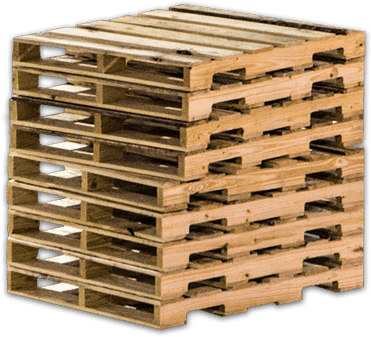

Rack
- A rack consists of huge metal frames joined together both vertically and horizontally. This is where the received goods are placed for storage.


Containers
- A container is a standard size metal box into which cargo is packed for shipment/storage.


Ladders
- Ladders – used to facilitate climbing to pick or stack light goods.
Hand truck/hand trolley
- These are used to move goods from the offloading bay and move within the warehouse.
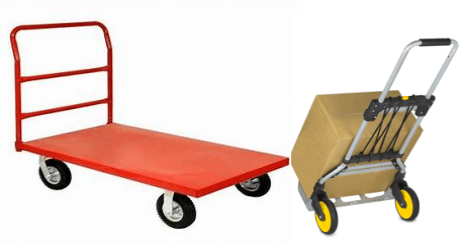

- These used to move pallets from one point to another.
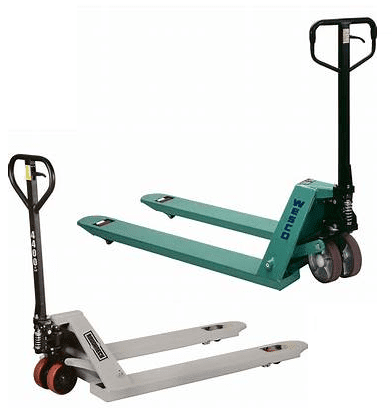

Forklift
- Provides a motorized means of movement of goods available in a range of sizes with carrying capacity from 1 to 40 tons.
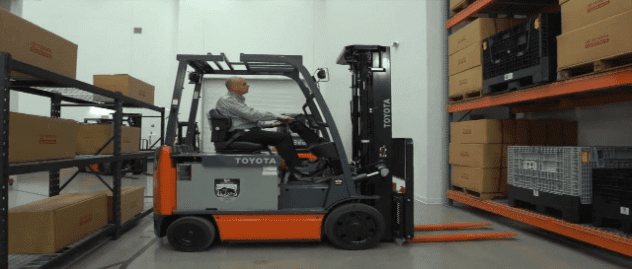

Reach Truck
- They are a variant on basic forklift design, have capability of moving their forks forward, backward as well as vertically and serve the same purpose as forklifts.
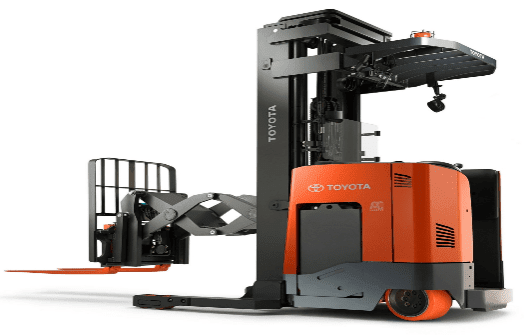

Pick stackers
- These are used for picking and stacking goods at high level in the truck or warehouse, can be driven to any location in warehouse.
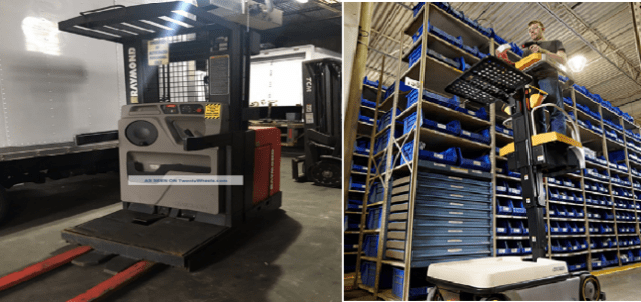

Crane
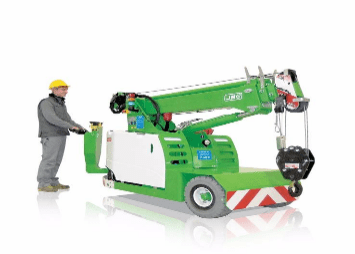

Types Of Docking Locations
Flush Dock
- The most common loading dock used in transport or heavy lifting, a flush dock allows for the back of the loading truck to be flushed against the entryway of a space.
- With a secure buffer to avoid damaging the wall, the dock is parallel to the building, maintaining easy and straightforward delivery of the items and materials to be loaded.
Open Dock
- Although rare, and unpopular with those in the trade, Open Docks are still used today. Consisting of an open platform with very little protection against natural elements – beyond a canopy – they do not create a secure enclosure for items, making them prone to theft and damage.
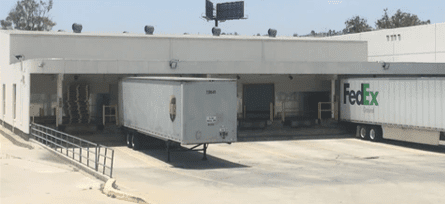

Saw Tooth Dock
- A saw tooth dock is one of the most innovative when it comes to manoeuvring small outdoor spaces surrounding the designated warehouse. Uniquely shaped at an angle, they can fit easily into narrow or difficult spaces.
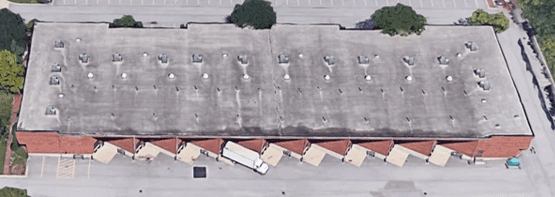

Enclosed Dock
- An enclosed dock is one of the most uncommon appliances used in deliveries. Allowing trucks to park indoors, aka inside a storage space or warehouse, gives loaders quick and easy to access to the supplies.
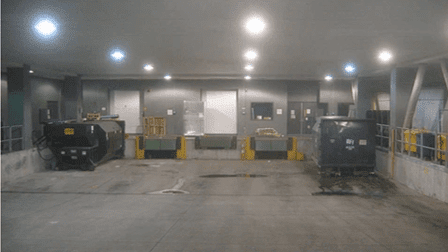

Confirmation Of Received Goods
- Involves ensuring the delivery has come to the right place by matching the details on the Consignment Note to the Purchase Order raised by your business.
- The Purchase Order should also be used to check that each item matches the description and quantities ordered
Ensure you record the following for each new delivery:
- The date and time goods arrived
- The name of the delivery partner and driver
- Check off quantities and description of goods against purchase order
- Note any discrepancies
- Names of the personnel who performed these checks
Check products are not damaged
- Before accepting the delivery, it’s important to conduct a quality check to ensure the items are not damaged or malfunctioning.
- If any damaged items are found in the delivery, record the extent of the damage on the consignment note and immediately notify the supplier with details of the issue to discuss the next steps.
Log received items into your inventory
- Enter the items you have received into your warehouse management system as soon as possible, including the date and quantities received.
- This will allow the stock to be allocated to new orders right away.
Allocate storage space for goods
- It’s important to pack away a new delivery promptly to ensure no items become lost or damaged.
- Supplies should be distributed to the appropriate person in the business, or packed away in the usual space to be accessed when required.
- For goods received in as stock, these items will need to be allocated a space in the warehouse for storage until ready to be picked for an order.
Goods Received Documentation
Consignment note
- A consignment note is a document regarding the carriage of goods by road which declares the contract of carriage and includes the instructions given to the carrier and proves the contract of carriage.
Consignment Note
The matters which must be included in a consignment note;
- The date of the consignment note and the place at which it is made out;
- The name and address of the sender;
- The name and address of the carrier;
- The place and the date of taking over of the goods and the place designated for delivery;
- The name and address of the consignee;
- The description, regarding common use, of the nature of the goods and the method of packing, and, in the case of dangerous goods, their generally recognized description;
- The number of packages and their special marks and numbers;
- The gross weight of the goods or their quantity otherwise expressed;
- Charges relating to the carriage;
- The requisite instructions for customs and other formalities;
- A statement that the carriage is subject, notwithstanding any clause to the contrary, to the provisions of this Convention.
Packing list / Slip
- A packing slip is a document that includes the complete list of items included in a package. Packing slips include marks and numbers, weights, dimensions, and the number of units that are used by shipping departments to determine what inventory needs to be sent out to accurately complete an order.
Goods Received Notes
- Goods received note (GRN) is a two-way document that acknowledges delivery of goods by a supplier and their receipt by the customer. When a customer issues a purchase order, the supplier is obligated to deliver them as per the terms of their contract. Upon delivery, the customer issues three delivery note copies to the department requesting the supplies, retains a copy for the finance department, and hands one over to the supplier. Goods received notes confirm that an order has been delivered and received and it’s satisfactory to all the parties involved.
Delivery Notes
- A copy of the Delivery Note is usually sent with the transporter. The Delivery Note contains the list of Items that are sent in the shipment and updates the inventory. The DN should have the name and contact details of the sender, name and contact details of the receiver, date of issue, date of delivery of the goods, description of the goods contained in the order, and the quantity of each type of goods.
Purchase Order
- A purchase order (PO) is a legally binding document created by a buyer and presented to a seller. A purchase order is essentially a list of what you want to buy. It lays out the order details, including quantity and types of products the buyer needs, as well as payment terms and delivery details.
Self-Assessment Questions and Activities on Receiving Operations
- “Explain the meaning of receiving of goods and describe the functions of receiving
- Using examples from a warehouse familiar to you, describe, in chronological order the steps involved in the receipt of goods.
- You are a newly recruited warehouse manager, among your duties is to recommend Material Handling equipment. Mention the types of equipment you would recommend for handling;
(i) Loose Cargo
(ii) Bulk Dry Cargo
(iii) Palletized Cargo
Self-Assessment Questions and Activities on Receiving Operations
- Using simple illustrations describe the common types of docking locations
- Explain any five ways how the goods verification process during receiving can be optimized.
- What challenges could arise from receiving goods into a warehouse without their relevant accompanying documents.
- Briefly explain how a warehouse known to you would plan and manage labour to receive a very large number of assorted consumer goods to be distributed in the festive season.
